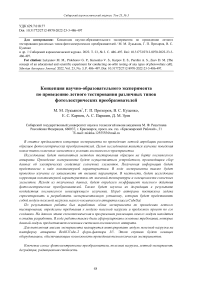The concept of an educational and scientific experiment for conducting on-orbit testing of any types of photovoltaic cell
Автор: Lukyanov M.M., Prokhorov G.P., Kutsenko V.S., Karpov E.S., Parshin A.S., Zuev D.M.
Журнал: Siberian Aerospace Journal @vestnik-sibsau-en
Рубрика: Aviation and spacecraft engineering
Статья в выпуске: 3 vol.23, 2022 года.
Бесплатный доступ
The article proposes the concept of an experiment for conducting flight testing of various samples of photo voltaic converters. The purpose of the experiment is to study the behavior of new types of solar cells in outer space. The research will be carried out by testing samples on board the spacecraft. The experiment will be carried out by a device that collects data on the electrical properties of solar cells. The information re-ceived will be presented in the form of a voltage characteristic. During the experiment, its dependence on external parameters will also be studied. In particular, the correlation of the current-voltage characteristic from the values of temperature and illumination of solar cells will be investigated. Based on the data ob-tained, the efficiency of photo voltaic converters will be determined. Their degradation as a result of expo-sure to cosmic ionizing radiation will also be studied. The authors are tasked with designing and develop-ing an experimental installation that will be a payload module of a small CubeSat-class spacecraft. Based on the results of the work, the appearance of the flight testing experiment was developed, the re-quirements for the payload module were determined and a project for its creation was proposed. At this stage, the circuit design and software implementation of the module itself are under development. In the course of the work, the main requirements that this module provides to the main systems of the spacecraft were also formulated. To carry out the mission of the experiment, it is planned to integrate the payload module on the plat-form of the ReshUCube-2 form factor 3U. This satellite will be equipped with equipment enabling techno-logical experiments.
Solar cells, payload, on-orbit experiment, degradation, radiation hardness
Короткий адрес: https://sciup.org/148329644
IDR: 148329644 | УДК: 629.7.018.77 | DOI: 10.31772/2712-8970-2022-23-3-486-497
Текст научной статьи The concept of an educational and scientific experiment for conducting on-orbit testing of any types of photovoltaic cell
Photovoltaic converters (PVC) are most often used on spacecraft (SC) as a primary source of electricity. Their main disadvantage is the deterioration of performance in the space environment. A large number of flying high-energy charged particles and ultraviolet radiation from the Sun cause the appearance of multiple defects. The degradation of solar panels is an urgent problem in the field of satellite engineering, since the operating time of a spacecraft in orbit is mainly determined by the state of its power supply system. According to the article [1], the largest share of failures that led to the failure of the mission of CubeSat satellites falls on this system. It is hardly possible to completely protect the panels from the destructive conditions of space. However, by increasing the efficiency of solar cells and reducing degradation by some order of magnitude, it is possible to increase the service life of space missions . Therefore, at present, several promising concepts of PVC with several p-n junctions for space applications are being developed all over the world [2]. And all of them need testing, because it is necessary to understand their behavior in orbit.
With the help of ground-based solar simulators, it is impossible to accurately recreate the spectrum of solar radiation in orbit, corresponding to zero atmospheric mass. (AM0) [3]. The value of the atmospheric mass determines the proportion of solar radiation absorbed by the Earth's atmosphere. Even experiments carried out on stratospheric balloons will not be able to inform us about the behavior of solar cells on a spacecraft board. In addition, under terrestrial conditions it is extremely difficult to reproduce the spectrum of cosmic ionizing radiation. Therefore, flight testing on the platform of nanosatellites of the CubeSat format, which do not impose high economic costs on developers, will be a rational way to obtain data on new technological solutions at the early stages of PVC testing. The flight validation method has experience of application in real missions of CubeSat satellites. In this format, experiments were carried out to determine the effectiveness of PVC and its decrease over time.
The basic method for studying the degradation of solar panels is to measure the operating current and determine the decrease in its value over time. Article [4] proposes an alternative method for monitoring the degradation of a satellite solar array using a photo voltaic model as a reference. This method can be used on any satellite that collects data on voltage, current, angle of incidence of sunlight and temperature of the solar array. The method consists in the use of degradation models, the use of photo voltaic models. There are two fundamental models. The first of them is the proton fluence model [5] proposed by the Jet Propulsion Laboratory (JPL). The second is the Displacement Damage Dose Model (DDD) [6] developed by the Naval Research Laboratory (NRL). As an example, an experiment was carried out on the first satellite produced by Singapore. – X-SAT [7]. This study compares theoretically and experimentally determined output characteristics of solar panels. Theoretical calculations use a photovoltaic model, and experimental verification was carried out on board the X-SAT spacecraft.
Publication [8] includes questions about setting up experiments in orbit on the example of the TacSat-4 mission [9]. The mission was to study the radiation resistance of solar panels, as well as their effectiveness in space conditions. TacSat -4 is launched into a highly elliptical orbit (HEO) with a size of 12,000 × 700 km, crossing both the electron and proton radiation belts [10]. The harsh environment of electron and proton radiation provides an excellent opportunity to test new photo voltaic technologies. As part of the experiment, ultrathin (100 μm) GaInP / GaInAs / GE triple junction solar cells were used, as well as a solar cell module with a stretched lens concentrator.
There is also experience in implementing the method of verification in orbit by universities. The purpose of the technical mission of the MOVE-II spacecraft was to measure the current-voltage characteristics of new multijunction solar cells [11]. This satellite was developed by the University of Munich and launched in early 2018 into a circular sun-synchronous orbit with an altitude of approximate-
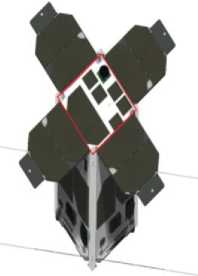
Рис. 1. Внешний вид спутника MOVE -II.
Область ПН выделена красной рамкой [11]
Fig. 1. The appearance of the MOVE-II satellite. The payload area is highlighted with a red border
ly 500 km. Its appearance is shown in Fig. 1.
In the Zenith payload module installed on this satellite, each solar cell is connected to a read circuit. The voltage sweep is controlled by a digital-to-analogue converter. Cell and shunt voltage signals are digitized using analog-to-digital converters. The temperature of each solar cell is measured by a digital sensor that is in direct thermal contact with the rear surface of the solar cell. In nominal mode, the satellite operates in a position where the payload is directed in the zenith direction (strictly towards the Sun). Additional data such as angle the tilt of the Sun and the visibility of the Earth are collected by the Attitude and Control System (ADCS) and are also included in the transmitted data. This input data is used for post-processing on Earth and to investigate the effect of the angle of incidence of the sun and the Earth's albedo on the performance of solar cells.
An example of a domestic mission to study new solar cells in space is the first satellite of the Far East "AmurSat" [12]. This is a 3U CubeSat weighing 3 kg, created by the Amur State University (AMSU) as part of the Universat-SOCRAT program. It was launched in July 2019 into a sun-synchronous orbit at a height of 530 km. The payload module "Photon - Amur", also developed by the
AmSU, was installed on this satellite’s board. The "Photon - Amur" device allows to study the currentvoltage characteristics of new photoelectric converters. The solar cells for this module were assembled from heterostructural elements grown in the university's own laboratory. The spacecraft is equipped with a universal platform to ensure the functionality of the module. Taking into account the design of the platform and the peculiarities of connecting payloads, the Photon-Amur device is made on two boards, one is a computing device, and the second is a panel of photoelectric converters. The basis of the platform is a microcontroller with internal flash memory. The data obtained during the experiment are accumulated in ROMand transmitted to the Earth during a communication session in portions of 256 bits. The format of the sent data contains the name of the module, the time of sending, and a block of parameters. These parameters include the values obtained by the current, voltage, temperature and illumination sensors of the solar cell. Based on the data received on Earth, the efficiency will be calculated and power of photoelectric converters, calculate the dependence of their characteristics on environmental factors – temperature, energy of the light flux, ionizing radiation and operating time. Module power consumption: average – 50 mA, peak – no more than 100 mA. The total payload weight is not more than 100 g. The results of tests in orbit did not reveal any significant remarks on the work of the payload. The data obtained from the instruments installed on the satellite confirmed the operability and suitability of the module for conducting a space experiment. Based on the results of the flight operation of the satellite, recommendations were formulated for improving the parameters and modes of on-board service systems and monitoring devices of payload for use in subsequent vehicles of this class.
There are many other examples of testing technological solutions on board a small spacecraft. And the accumulated experience should be used in the design of new similar missions. This article presents a project of a pay-load module for a CubeSat class spacecraft for flight testing of various types of solar cells. The developed device must comply with the requirements and restrictions that are defined by the satellite format.
Parameters and characteristics of solar cells determined during the experiment
The output data will be the instantaneous values of the current produced by the solar cell, depending on the voltage falling on it. The combination of current values and corresponding voltage values will be used to plot the points of the current-voltage characteristic curve (CVC) of the solar cell. Each obtained set of CVC points will be assigned the corresponding value of the Sun position angle. This angle will help to determine the illumination of the solar cells. Conducting a qualitative and quantitative analysis of the CVC curve, using the known values of illumination and surface area of the solar cell, the value of its efficiency will be obtained. Efficiency Monitoring for some time will allow to investigate the degradation of the solar cell. Also, each cycle of measurements will be accompanied by a temperature measurement of the solar cell.
Flight experiment methodology and operating cycles
As a methodology for the experiment, it is proposed to use the methodology underlying the mission КА MOVE -II [11]. As part of the experiment in orbit, experiments are proposed to determine the dependence of the CVC of solar cells on the angle of illumination and temperature.
To implement these experiments, the payload module will be conducted in two modes:
-
1) illumination angle measurement mode;
-
2) temperature change mode.
The sequence of these two modes will constitute the operating cycle.
The determination of the CVC dependence on the angle of the Sun position will be carried out using the Orientation and Stabilization System, as well as the solar sensor. In the mode of changing the angle of illumination, the spacecraft will need to make a turn. In the initial position, the payload module of the satellite will be oriented at an angle of 90° relative to the direction of the Sun, as shown in Fig. 2 on the left. End position the module will be oriented strictly to the Sun (Fig. 2 on the right).
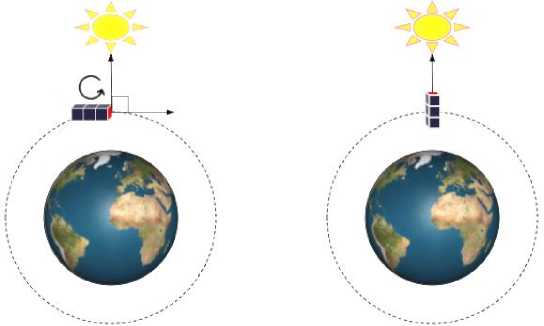
Рис. 2. Схематичное представление начального и конечного положения КА в режиме изменения угла освещенности
Fig. 2. Schematic representation of the initial and final position of the spacecraft in the mode of changing the illumination angle
During the maneuver, sets of CVC points will be collected for preset values of the angle of the position of the Sun. To carry out this experiment, there is a need to minimize the turning time in order to avoid a sharp temperature jump during the operating cycle. The timing of this phase of the work cycle will be specified.
In the temperature change mode, the module will be oriented strictly to the Sun during the entire measurement cycle.
According to the source [13], during the passage of a small spacecraft located in low Earth orbit, the temperature on the solar panels that are oriented to the Sun can reach up to 80 ºС, and the temperature of systems that are not exposed to direct sunlight is from 20 ºС.
If the I-V curves can be obtained at different temperatures, then it will be possible to determine the corresponding temperature coefficients. Knowledge of the CVC dependence on temperature will also help to calibrate in an experiment with a change in the angle of the Sun.
Obviously the results of the experiment will be significantly affected by the light reflected from the Earth. For the purity of the experiment, in the article [14] it is proposed to carry out measurements in a pre-predicted time interval, when the satellite will be near the "noon" of the orbit, in order to ensure optimal illumination of solar cells without the Earth's albedo . The "noon" of the orbit is understood as such a point in the orbit, which is strictly between the Earth and the Sun.
Payload module look
A payload module project is proposed. It will be constructed on a single board. On the outside of the board there will be verifiable photoelectric converters, as well as a solar sensor (which will be a collection of low resistance photoresistors). The module will be installed on the end side of the spacecraft.
Solar cells will be small (2-3 cm). Their number on the experimental module will be 5-6 pieces . For experimental study of the effects of degradation, one of the elements will be installed in the form of a bare cell, i.e. without a protective glass. In the future, the dimensions and number of cells will be specified.
Each solar cell will be connected to a reading circuit. Temperature measurement will be carried out by the sensor in the place of direct thermal contact with the rear surface of each solar cell. It is planned to sweep the curve of current versus voltage by changing the resistance of the digital load block, which will serve as a variable electronic load. Variable resistance control will be carried out using a micro control- ler. The digital load chip has 63 resistors connected in series. With the help of a control signal supplied to the microcircuit, it is possible to change the number of resistors involved in the electrical circuit. The solar cell voltage UC is measured directly between the positive and negative terminals of the solar cell. The current is measured as the voltage drop across a precision shunt resistor R with a small resistance and a low temperature coefficient.
As a device that measures current and voltage, as well as digitizing their values, it will be convenient to use a ready-made microcircuit like INA 266. The connection of
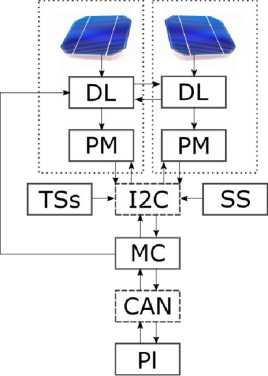
Рис. 3 Функциональная блок-схема:
DL – блок цифровой нагрузки; PM – Power monitor INA266
I2C – интерфейс I2C; TSs – датчики температуры;
SS – датчик освещения; MC – микроконтроллер;
CAN – интерфейс CAN; Pl – платформа ReshUCube-2
this microcircuit with external devices, and in particular, with a micro controller (indicated by the abbreviation MK in Fig. 3), can be established via the interface I 2 C . To communicate the payload micro controller with the CubeSat class spacecraft platform, it is customary to use the CAN bus. This solution has a wide range of applications.
Fig. 3 presents a diagram showing the relationship between payload components and spacecraft platform. The dotted line marks
Fig. 3 Functional block diagram:
DL – digital load unit; PM – Power monitor INA266;
I2C – I2C interface; TSs – temperature sensors;
SS – light sensor; MC – microcontroller;
CAN – CAN interface; Pl – ReshUCube-2 platform
the reading circuits, removing CVC from solar cells. The illustration shows only 2 blocks reading circuits for a visual representation of the interaction of these blocks with the micro controller.
Volume of generated data
All generated data will be represented as float variables with a volume of 4 bytes.
The number of points for the CVC will be determined by the accuracy of current and voltage measurements. The measurement accuracy, in turn, is determined mainly by the temperature and radiation stability of the circuit elements.
It is planned that the CVC will contain about 20 points. Each CVC data set will correspond to the temperature values and the angle of the Sun position at the moment of measurement.
In the case of using a solar sensor of the QD photodiode type, the sensitive element of which consists of four independent photodiodes, the corresponding 4 values of the output voltages of the photodetectors will be obtained. These values will be processed on Earth and the position of the Sun will be unambiguously determined from their ratio.
The information volume of one complete set of CVC data will be 420 bytes.
Multiplying this value by the number of solar cells under study (we take 5), we get 2100 bytes of information.
It is planned, as far as possible, to consistently combine the experiment with a change in the angle of inclination and the experiment with a change in temperature. It is proposed to carry out 10 measurements for an angle from 0 to 90° in 10° steps, as well as additional measurements for angles of 5° and 85° (to more accurately determine the possible influence of reflection effects). Total: 12 measurements. For the experiment with temperature change, it is preliminary planned to carry out 10 measurements, for example: with a step at 5 ºС in the range from 25 to 75 ºС. ВAs a result, preliminary we have 12 + 10 = 22 cycles of CVC measurements, the information volume of which will be 19,800 bytes (about 19.3 Kb) (see table).
Generated amount of data
|
CVC data set for one solar cell |
Number of CVC |
Data volume of one complete set, bytes |
Number of sets |
The volume of the data packet received for the full cycle of measurements, bytes |
|||
|
Measured parameters |
Parameter weight, bytes |
Number of measurements |
Total data volume, bytes |
||||
|
Current |
4 |
20 |
80 |
||||
|
Voltage |
4 |
20 |
80 |
||||
|
Angle of incidence |
4 |
4 |
16 |
||||
|
Temperature |
4 |
1 |
4 |
||||
|
Total |
45 |
180 |
5 |
900 |
22 |
19800 |
|
It is planned to receive a complete data packet from the payload module once a week, after sending an appropriate telecommand with time reference via the communication channel from the Mission Control Center (MCC) to the spacecraft.
Enabling communication with the payload module and receiving data
The control of the payload operating cycle start will be carried out using the radio communication of the spacecraft telecommunications system with the ground station by the mission control center. The process of launching the experiment on board will include the following steps:
-
1. Sending a telecommand from the mission control center to the spacecraft via the uplink of the communication channel [15] with reference to time.
-
2. Reception of a telecommand by the telecommunications system of the satellite and transmission to the onboard control system.
-
3. Sending from the on-board computer at a given time the command to start the experiment through the multiplexer via the I 2 C bus to the payload microcontroller.
The software that implements the experiment will be loaded into the microcontroller.
The principle of obtaining data from the payload module:
-
1. Measurement of a set of values of currents and corresponding voltages issued by a photoelectric converter.
-
2. Obtaining the corresponding values from the solar position and temperature sensors angle of position of the star and temperature.
-
3. The measured parameters are sent to the microcontroller, which forms a data packet as an excel spreadsheet or text file.
-
4. The microcontroller transmits the packet through the multiplexer via the I 2 C interface to the onboard computer.
-
5. During the appearance of the communication channel, the data packet is transmitted to the MCC in the form of telemetry.
Minimum platform requirements
The payload module under development will be installed on the end side of the CubeSat form factor satellite 3 U [16]. he measuring circuit will be printed on the bottom side of the board. On the top side of the board, pins will be made for soldering the CVC. The ends of the rails must have areas for contact with adjacent devices during launch.
The minimum size of these zones: 6.5 mm (Fig. 4). This zone imposes a restriction by the height of the components installed on the board. Height refers to the dimension along the Z axis.

Рис. 4. Торцевой и боковой виды 3 U CubeSat
Fig.4. End and side views of 3U CubeSat
The board has dimensions of 100 х100 mm and has square cuts at the corners with a depth of at least 8.5 mm for installation on rails (metal frame). In addition to solar cells, a solar sensor will be placed on the front side of the board (shown in Fig. 5 as a circle divided into 4 sectors).
It is also worth noting the conditions imposed by the nature of the experiment on the orbit of the spacecraft. To implement the study of degradation effects, the satellite orbit must somehow pass through the Van Allen radiation belts [10]. It is planned that the ReshUCube-2 spacecraft will be launched into low earth orbit. The lower limit of the increase in the intensity of emission of charged particles (protons) begins at an altitude of 500 km (above the Atlantic). Therefore, it is advisable that the satellite orbit be polar and lie above this mark. In addi-
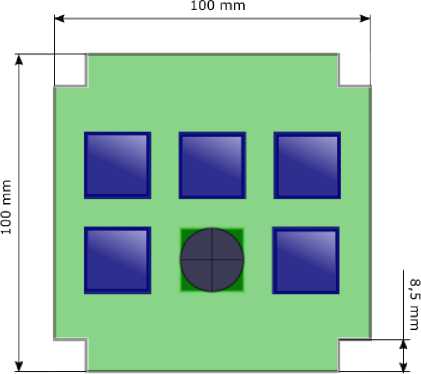
Рис. 5. Плата модуля полезной нагрузки
Fig. 5. Payload Module board
tion, for the purity of the experiment, it is necessary to simulate the orbit to predict the time when the satellite will pass around "noon" orbits. This will ensure optimal illumination of solar cells without the Earth's albedo.
The characteristics of service systems determine the type and capabilities of the payload [15]. The 19.3 kb of data generated by the payload module will not provide high demands on the interface and telecommunications system. The transfer time for such a volume of data via the I 2 C protocol (at a speed of 100 Kbps) will be approximately 1.5 s. Often CubeSat's onboard telecommunication system uses a VHF/UHF transmitter. The minimum downlink telemetry bit rate is 9600 bps. At this speed, the generated data will be sent to Earth in 16.5 seconds. If we take into account that 30% of the message will be occupied by protocol data (service information), then sending a data packet will take a total of 24.6 seconds.
During the reorientation mode, during the payload module operation cycle, the spacecraft will have to perform a maneuver: turn by 90°. The turning speed will be limited by the capabilities of the Orientation and Stabilization System. Preliminarily estimated requirements for orientation accuracy have a standard value: no more than 10° deviation from the given position. This parameter will be affected by the accuracy of the Solar Sensor.
Implementation on the spacecraft platform
It is supposed to implement the space mission of the payload module on board the ReshUCube-2 satellite. The device is currently under development. It will develop the ideas embodied in the first ReshUCube created by Reshetnev SibSU [17]. First of all, this concerns the implementation of a reconfigurable space laboratory. As conceived by the project, it was planned to use the obtained data in the framework of educational and scientific activities.
The principle of such a laboratory operation is to control the payload operation modes by downloading software to the spacecraft during the flight. The devices are managed by the payload controller. ReshUCube is equipped with a wide range of equipment for conducting various scientific technological experiments. On the platform of satellites of this series, several payload modules of a different nature are installed, including those that perform testing and flight testing of new technological solutions.
Conclusion
Traditionally, spacecraft, including small ones, in particular, nanosatellites of the CubeSat class, are used to conduct scientific and technological experiments. In this paper the shape of the experiment on testing photovoltaic cells designed to be carried out on the payload module of a nanosatellite of the CubeSat class, is formulated. Within the framework of the image, the methodology for testing photoelectric converters is determined, the working cycles of the experiment are described. Taking into account the basic requirements imposed by the experimental technique, a design of a testing device was developed. The project discloses a method for the circuit implementation of the device, presents a functional diagram of the module, demonstrating its main components. During the development of the payload module, it is planned to use commercially available solutions when choosing components, which corresponds to the general philosophy of the CubeSat class nanosatellites.
Carrying out the experiment in the conditions of the space environment will provide an idea of the true behavior of solar cells in orbit. Experiments of this kind cannot have full-fledged terrestrial analogues due to the impossibility of modeling all the active factors of outer space. Therefore, projects for conducting such experiments attract the attention of developers who want to obtain a flight history for their products.
The CubeSat format [16] improves the convenience of the experiment due to specifically defined standards for satellites of this type. In addition, conducting an experiment on board the CubeSat is a budget option for research. A concept reconfigurable space laboratory ReshUCube will prevent the satellite from becoming useless after the end of a predetermined experimental program and will help to use the resources of the device with maximum efficiency.
Список литературы The concept of an educational and scientific experiment for conducting on-orbit testing of any types of photovoltaic cell
- Enhancing Lifetime of 1U/2U CubeSat Electric Power System with Distributed Architecture and Power-down Mode / A. Edpuganti, V. Khadkikar, H. Zeineldin et al. // IEEE Transactions on Industry Applications. 2022. Vol. 58. P. 901–913.
- 3–6 Junction photovoltaic cells for space and terrestrial concentrator applications / F. Dimroth, C. Baur, A. W. Bett et al. // 31st IEEE Photovoltaic Specialists Conference, 2005. P. 525–529.
- AM0 solar cell calibration under near space conditions / R. Hoheisel, D. Wilt, D. Scheiman et al. // IEEE 40th Photovoltaic Specialist Conference. 2014. P. 1811–1814.
- A Photovoltaic Model Based Method to Monitor Solar Array Degradation On-Board a Micro-Satellite / Jing Jun Soon, Jiun Wei Chia, Htet Aung et al. // IEEE. 2018. 10 p.
- Feynman J., Ruzmaikin A., Berdichevsky V. The JPL proton fluence model: an update // Journal of Atmospheric and Solar-Terrestrial Physics. 2002. Vol. 64. P. 1679–1686.
- Modeling solar cell degradation in space: A comparison of the NRL displacement damage dose and the JPL equivalent fluence approaches / S. R. Messenger, G. P. Summers, E. A. Burke et al. // Progress in Photovoltaics: Research and Applications. 2001. Vol. 9. P. 103–121.
- Bretschneider T. Singapore’s satellite mission X-Sat // Proceedings of the International Acade-my of Astronautics Symposium on Small Satellites for Earth Observation. 2003. P. 105–108.
- Solar Cell experiment for Space: Past, Present and Future. R. Hoheisel, S. R. Messenger, M. P. Limb et al. // Proceedings of SPIE – The International Society for Optical Engineering. 2013. Vol. 8620. 7 p.
- TACSAT-4 solar cell experiment: Advanced solar cell technologies in a high radiation envi-ronment / P. Jenkins, M. Krasowski, N. Prokop et al. // IEEE 44th Photovoltaic Specialists Confer-ence. 2009. P. 9–12.
- Space Weather Effects in the Earth’s Radiation Belts / D. N. Baker, P. J. Erickson, J. F. Fennell et al. // Space Science Reviews, 2018. Vol. 214. 17 p.
- On-orbit verification of space solar cells on the CubeSat MOVE-II / M. Rutzinger, L. Krempel, M. Salzberger et al. // Munich: Technical University of Munich. 2016. 5 p.
- Фомин Д. В. «АмГУ-1» («АмурСат») – первый спутник АмГУ // Космонавтика: наука и образование: материалы Всерос. науч. конф. (17 октября 2019, г. Благовещенск) / под общ. ред. В. В. Соловьева ; Ам. гос. ун-т. Благовещенск, 2019. С. 15–18.
- New Methodologies for the Thermal Modeling of CubeSats / R. Philipp, P. Hager, C. Lucking et al. // 26th Annual AIAA/USU, Conference on Small Satellites. 2012. 11 p.
- On-Orbit Characterization of Space Solar Cells on Nano-satellites / J. Lee, J. Nocerino, B. Hardy et al. // IEEE 44th Photovoltaic Specialists Conference. 2017. P. 1–6.
- Чеботарев В. Е., Косенко В. Е. Основы проектирования космических аппаратов информационного обеспечения: учеб. пособие / Сиб. гос. аэрокосмич. ун-т. Красноярск, 2011. 488 с.
- Electronic textbook [Электронный ресурс]. URL: https://www.cubesat.org (дата обращения: 25.09.2021).
- Ханов В. Х., Зуев Д. М., Шахматов А. В. Реализация полезной нагрузки ReshUCube как реконфигурируемой космической лаборатории // Решетневские чтения: материалы XXV Междунар. науч. конф. (10–12 ноября 2021, г. Красноярск): в 2 ч. / под общ. ред. Ю. Ю. Логинова ; Сиб. гос. аэрокосмич. ун-т. Красноярск, 2021. С. 417–418.

